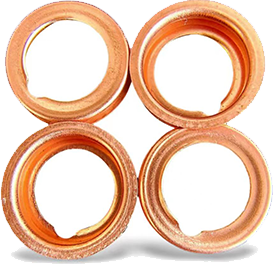rear crank seal
Understanding Rear Crank Seals Importance and Maintenance
When it comes to the functioning of a vehicle's engine, every component plays a crucial role. Among these components, the rear crank seal is often overlooked despite its significant impact on the engine's performance. This article delves into the importance of rear crank seals, their functions, common problems, and tips for maintenance.
What is a Rear Crank Seal?
The rear crank seal is a rubber or silicone seal located at the rear end of the engine's crankshaft. Its primary function is to prevent oil from leaking from the engine oil sump and allow the crankshaft to rotate freely. This seal is vital because it not only protects the engine from oil leaks but also helps maintain the necessary oil pressure for effective lubrication.
The Importance of Rear Crank Seals
Maintaining a functional rear crank seal is crucial for several reasons
1. Preventing Oil Leaks A damaged or worn-out crank seal can lead to oil leaks, which can reduce oil levels and affect overall engine performance. Low oil levels can result in increased friction, leading to engine wear and potential catastrophic failure.
2. Maintaining Engine Pressure The rear crank seal plays a vital role in maintaining proper oil pressure within the engine. Oil pressure is essential for lubrication, which helps prevent engine parts from grinding against each other and wearing down prematurely.
3. Protecting Components Any oil leak from the rear crank seal can lead to the accumulation of grime and dirt on engine components. This can cause further damage and contribute to a less efficient running engine.
Common Problems Associated with Rear Crank Seals
rear crank seal

Despite their importance, rear crank seals can experience several issues over time, often due to wear and tear or improper installation. Here are some common problems
- Oil Leakage This is the most obvious sign of a failing rear crank seal. If you notice oil puddles under your vehicle, it might be time to inspect the rear crank seal for damage.
- Engine Performance Issues A degraded seal can lead to reduced oil pressure, which may cause performance issues such as overheating or a decline in power.
- Contaminated Oil A damaged rear crank seal can lead to contaminants entering the oil system, which can impact overall engine performance and longevity.
Maintenance and Replacement
Maintaining a rear crank seal involves regular inspections, especially if you notice any signs of oil leaks or performance issues. Here are a few tips
1. Regular Oil Changes Make sure to follow your vehicle manufacturer’s recommended oil change intervals. Fresh oil helps in keeping the engine clean and can prolong the life of the seals.
2. Routine Inspections During regular maintenance checks, get your mechanic to inspect the rear crank seal for any signs of wear or leakage.
3. Proper Installation If you need to replace the rear crank seal, ensure that it is installed correctly to avoid premature failure. This is a job best suited for a professional mechanic if you are not experienced.
In conclusion, the rear crank seal is a small but vital component of your vehicle's engine. Understanding its importance and recognizing its common issues can help you maintain your engine's health, ultimately ensuring better performance and longevity. Regular maintenance and timely replacements can save you from costly repairs down the line.
-
Understanding the Front Main Engine Seal: Purpose, Maintenance, and Installation
News Jul.29,2025
-
Understanding O-Rings and Seal Rings: Types, Applications, and Custom Solutions
News Jul.29,2025
-
Understanding Crankshaft Oil Seals: Rear Seals, Pulley Seals, and Their Role in Engine Integrity
News Jul.29,2025
-
The Importance of Front and Rear Crankshaft Seals in Engine Performance and Oil Management
News Jul.29,2025
-
Crank Oil Seals: Functions, Types, and Cost Considerations in Engine Maintenance
News Jul.29,2025
-
A Comprehensive Guide to O-Rings and Seals: Types, Materials, and Global Applications
News Jul.29,2025
-
Mastering Diesel and Performance Engine Maintenance: A Guide to Critical Oil Gaskets
News Jul.28,2025
Products categories















